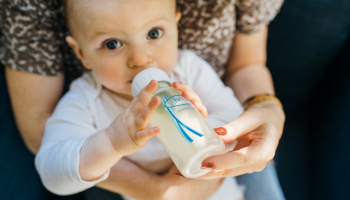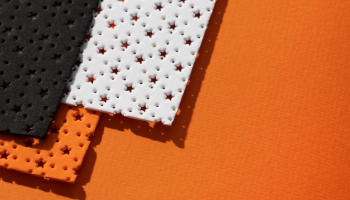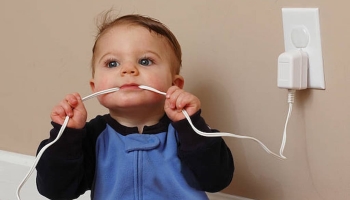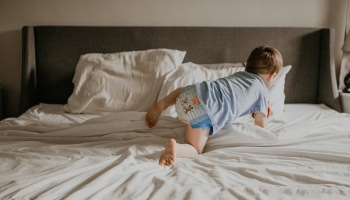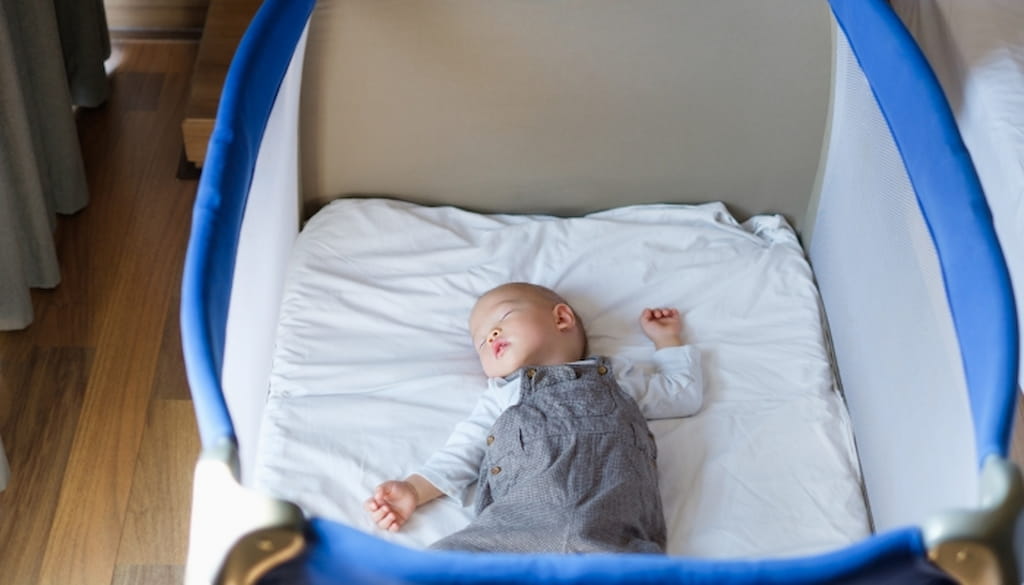
Pack and plays are a popular choice for parents looking for a safe sleep space and convenient environment for their infants. These portable cribs are easy to set up and can be used for napping or nighttime sleep. However, many parents wonder how long their sleeping babies can safely rest in a pack and play.
For naps, the Pack ‘n Play is suitable for any length of nap that your baby might take.
For overnight sleeping, it’s also suitable as long as it’s in a safe environment and you’re using a well-fitting, firm mattress (avoid adding soft bedding, which can be a suffocation hazard).
According to the American Academy of Pediatrics (AAP), infants should practice room sharing and sleep in the same room as their parents for at least the first six months of life to reduce the risk of sudden infant death syndrome (SIDS). While a pack n play can be a suitable sleep environment for an infant, it’s essential to follow safe sleep guidelines to reduce the risk of suffocation and other hazards.
Key Takeaways
- Pack n plays can offer a safe sleep space for infants, but it’s vital to adhere to safe sleep guidelines to mitigate the risk of suffocation and other hazards.
- When choosing a pack n play, consider your baby’s weight and height as well as their developmental stage.
- Regularly check the pack n play for signs of wear and tear or damage that could pose a safety risk.
How Long Can a Baby Sleep in a Pack n Play by Age?
Newborn to 3 months
Newborns and infants up to about 3 months can sleep in the bassinet attachment of a Pack ‘n Play. This attachment is designed for younger babies and can be a safe sleeping environment provided the baby has not exceeded the weight limit, which is typically around 15 pounds (though you should always check the specific weight recommendations for the model you have).
4 months to 6 months
As babies grow and become more mobile, it’s essential to transition them from the bassinet attachment to the bottom of the Pack ‘n Play. At this age, they can roll over, and the bassinet might not be safe if they exceed the weight limit or can push up on their hands and knees.
7 months to 12 months (and beyond)
Once babies are more mobile and start sitting up, pulling up, or even attempting to stand, the bottom of the Pack ‘n Play can still be a safe sleep environment. However, always be observant of your baby’s developmental milestones. If they try to climb out, it becomes a safety risk, and you’ll need to transition them to a more appropriate sleep environment.
Note: It’s essential to check the specific weight and height recommendations of the Pack ‘n Play model you own. Some can accommodate toddlers up to 35 pounds or until they’re able to climb out.
General considerations: Regardless of age, always ensure that the Pack ‘n Play’s mattress is firm, without any gaps between the mattress and the mesh sides. Refrain from adding soft bedding, pillows, or toys, as these can pose suffocation hazards. Regularly inspect the Pack ‘n Play for signs of wear and tear, ensuring that all latches and sides are securely locked in place.
Pack and Play as a Sleep Environment
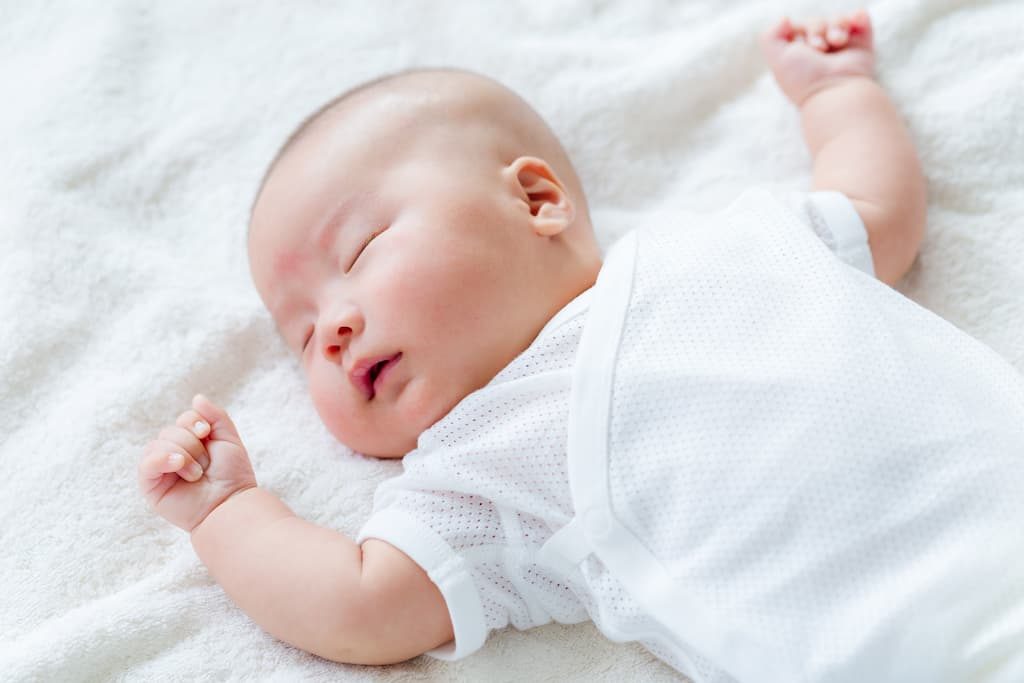
A pack n play can be a comfortable and safe sleep space for babies. It’s a portable play yard that can also function as a temporary sleep space. The mesh sides provide ventilation and visibility, and the bassinet attachment can be used for newborn sleep.
When using a pack n play for sleep, ensure that the mattress is firm and fits snugly in the play yard. Bedding should be minimal and fit tightly to avoid suffocation hazards. It’s recommended to use a fitted sheet and avoid soft items like pillows and blankets.
Parents should also ensure that the pack n play is set up in a baby safe environment. This includes keeping it away from hazards such as cords, blinds, and other objects that could pose a strangulation or suffocation risk. The room temperature should be comfortable, and the play yard should not be near a heat source or drafty area.
It’s essential to understand that a pack n play shouldn’t serve as a long-term sleep solution. As babies grow and become more mobile, they may outgrow the bassinet attachment and need a more permanent sleep space like a crib or toddler bed. Moreover, it’s suggested that babies sleep in the same room as their parents for at least the first six months to reduce the risk of Sudden Infant Death Syndrome (SIDS).
Safe Sleep Guidelines

When it comes to safe sleep guidelines, it is important to follow the recommendations of the American Academy of Pediatrics (AAP). The AAP recommends that infants should always be placed on their back to sleep for every sleep, including naps. This is the safest position for infants to reduce the risk of Sudden Infant Death Syndrome (SIDS).
It’s also crucial to ensure that the sleeping environment is safe. A pack n play can serve as a safe sleep environment for infants, but adherence to specific guidelines is necessary for baby safety. The pack n play should be set up following the manufacturer’s instructions and have a firm, flat sleep surface. Loose bedding, such as blankets, pillows, and bumper pads, shouldn’t be placed in the pack n play with the baby, as these items can heighten the risk of suffocation and SIDS.
Parents should also ensure the pack n play is free from hazards, such as cords or strings, posing a strangulation risk. The pack n play should be positioned in a safe location, away from any hazards like cords, blinds, or curtains.
It is important to note that a pack n play should only be used as a temporary sleep option for infants. As the baby grows and becomes more mobile, they will need a larger sleep space that is designed for their age and development.
In summary, following safe sleep guidelines is crucial for mitigating SIDS risks. A pack n play can provide a safe sleep space for infants if used appropriately and in alignment with the manufacturer’s instructions.
Weight and Height Considerations
When it comes to using a pack n play for sleeping, parents should take into consideration their baby’s weight and height. Pack and plays have weight and height limits that must be adhered to in order to ensure the safety of the baby.
Most pack and plays have a weight limit of around 30 pounds, but it is important to check the specific model’s weight limit before using it for sleeping. If a baby exceeds the weight limit, it can cause the pack and play to collapse, which can be dangerous.
Height limits are also important to consider. Most pack and plays have a height limit of around 35 inches, but again, it is important to check the specific model’s height limit before use. If a baby exceeds the height limit, it can cause the baby to become trapped or fall out of the pack n play.
Parents should also consider the size of the pack and play in relation to their baby’s size. If the pack and play is too small for the baby, it can be uncomfortable and may not provide enough space for the baby to move around. On the other hand, if the pack and play is too big for the baby, it can be difficult to keep the baby warm and secure.
Here you can check how to make pack n play more comfortable for your baby.
In summary, parents should always check the weight and height limits of a pack and play before using it for sleeping. It is also important to consider the size of the pack and play in relation to the baby’s size to ensure their comfort and safety.
Suffocation and Strangulation Hazards
When it comes to pack n plays, parents need to be aware of the potential suffocation and strangulation hazards that can occur. Suffocation is the leading cause of injury-related death among children under the age of one, and it can happen quickly and silently.
One of the most significant suffocation hazards in a pack n play is the use of pillows or other soft bedding. The American Academy of Pediatrics (AAP) recommends that parents avoid putting any soft objects in the pack and play, including pillows, blankets, and stuffed animals. These items can pose a suffocation hazard if the baby rolls over and becomes trapped underneath them.
Another suffocation hazard to be aware of is the use of a pack n play with a bassinet attachment. While these attachments can be convenient for newborns, they can also pose a risk if the baby rolls over and becomes trapped between the bassinet and the mesh sides of the pack and play.
In addition to suffocation hazards, parents also need to be aware of the risk of strangulation in a pack and play. This can occur if the baby’s head or neck becomes trapped between the side of the pack and play and the mattress. To prevent this, parents should always ensure that the mattress fits snugly in the pack and play and that there are no gaps between the mattress and the sides.
Pack and Play for Different Developmental Stages
Pack and plays are a great option for parents who need a portable and safe sleeping space for their baby. However, the amount of time a baby can sleep in a pack and play varies depending on their developmental stage.
Newborns can sleep in a pack and play for longer periods of time, as they are not yet mobile and do not require as much space to move around. However, it is important to note that newborns should not sleep in a pack and play for extended periods of time, as they need frequent feedings and diaper changes.
As infants grow and reach developmental milestones such as rolling over, they may need more space to move around and explore. It is important to monitor your baby’s growth and development to ensure they are safe and comfortable in their sleeping space.
By the time a baby is around 6 months of age, they may start to outgrow a pack n play and require a larger sleeping space. At this stage, parents may want to consider transitioning their baby to a crib.
It is important to note that every baby is different and may reach developmental milestones at different times. Parents should monitor their baby’s growth and development and adjust their sleeping arrangements accordingly.
Overall, pack and plays can be a great option for parents who need a portable and safe sleeping space for their baby. However, it is important to consider your baby’s developmental stage and adjust their sleeping arrangements as needed.
Maintenance and Safety Checks
When it comes to using a pack and play for a baby, maintenance and safety checks are crucial to ensure the baby’s safety. Here are some guidelines that parents should follow:
Safety Guidelines
Before placing a baby in a pack and play, parents must ensure that the pack and play meets all safety guidelines. This includes checking for any recalls, ensuring that the pack and play has not been damaged, and that it has not been modified in any way.
Diaper Changes
When changing a baby’s diaper in a pack and play, parents should ensure that the changing table attachment is securely fastened and that the pack and play is on a level surface. Additionally, parents should never leave a baby unattended on the changing table.
Structural Integrity
Parents should regularly inspect the pack and play’s structural integrity. This includes checking for any signs of wear and tear, such as frayed edges or broken parts. If any damage is found, parents should immediately stop using the pack and play and replace it.
Gaps
Parents should also check for any gaps in the pack and play. Gaps can pose a danger to a baby, as they can get their fingers or other body parts caught in them. Parents should ensure that there are no gaps between the pack and play’s mattress and the sides of the pack and play.
Sturdy Construction
When purchasing a pack and play, parents should ensure that it is made of sturdy construction. This will ensure that the pack and play can support the baby’s weight and that it will not collapse or tip over.
Other Considerations
While pack and plays are generally safe and convenient sleeping options for babies, there are a few other factors to consider when using them.
Temperature
It’s important to ensure that the baby’s sleeping environment is at a comfortable temperature. While pack and plays are designed to have mesh sides for ventilation, they may not provide enough warmth in cooler temperatures. Conversely, if the room is too warm, the baby may become overheated. It’s recommended to dress the baby in appropriate clothing and use a thermometer to monitor the temperature in the room.
Distractions
Pack and plays can be a great way to keep a baby contained and safe while allowing them to play and explore. However, it’s important to be mindful of any distractions that may interfere with their sleep. Mobiles or other toys attached to the pack and play may be entertaining for the baby, but they could also keep them awake or overstimulated.
Nap Routines
Establishing a consistent nap routine can be beneficial for both the baby and the caregiver. While pack and plays can be used for naps, it’s important to ensure that the baby is comfortable and familiar with the sleeping environment. This may mean using the pack and play for naps at home before using it for overnight sleeping while traveling.
Co-Sleeping
While pack and plays are a safe sleeping option for babies, some parents choose to co-sleep with their baby. It’s important to note that the American Academy of Pediatrics recommends against bed-sharing with infants, as it can increase the risk of suffocation or sudden infant death syndrome (SIDS).
Juvenile Products Manufacturers Association (JPMA)
The Juvenile Products Manufacturers Association (JPMA) is a trade organization that represents companies that manufacture juvenile products, including pack and plays. JPMA provides safety standards and guidelines for manufacturers to follow to ensure the safety of their products.
Healthy Development
Babies spend a significant amount of time sleeping, and it’s important to ensure that their sleeping environment promotes healthy development. Pack and plays are designed to be safe and comfortable for babies, but it’s important to monitor the baby’s development and adjust their sleeping arrangements as needed.
U.S. Consumer Product Safety Commission
The U.S. Consumer Product Safety Commission (CPSC) is a government agency that regulates the safety of consumer products, including pack and plays. CPSC provides safety guidelines and regulations for manufacturers to follow to ensure the safety of their products.
Mobiles
Mobiles can be a fun and entertaining addition to a pack and play, but it’s important to ensure that they are safe and appropriate for the baby’s age. Mobiles should be securely attached to the pack and play and should be free from any small parts that could pose a choking hazard.
Bond
Using a pack and play can be a great way to bond with a baby while providing a safe sleeping environment. It’s important to be present and attentive while the baby is in the pack and play, and to respond to their needs in a timely and appropriate manner.
Frequently Asked Questions
What is the recommended age range for using a pack and play for sleep?
The recommended age range for using a pack and play for sleep is from newborn to around 3 years old. However, it’s important to follow the manufacturer’s guidelines for weight and height limits.
What is the weight limit for a baby to sleep in a pack and play?
The weight limit for a baby to sleep in a pack and play varies by model, but most pack and plays have a weight limit of around 30 pounds. It’s important to follow the manufacturer’s guidelines to ensure the safety of your baby.
Can a baby sleep in a pack and play every night?
Yes, a baby can sleep in a pack and play every night. However, it’s important to ensure that the pack and play is set up correctly and that the baby is placed in the pack and play in a safe sleeping position.
Is it safe for a baby to sleep in a pack and play?
Yes, it is safe for a baby to sleep in a pack and play as long as the pack and play is set up correctly and the baby is placed in a safe sleeping position. It’s important to follow the manufacturer’s guidelines and to ensure that the pack and play is free from any potential hazards.
What are the benefits of using a pack and play for a baby to sleep?
Using a pack and play for a baby to sleep has several benefits, including portability, ease of use, and affordability. Pack and plays are also versatile and can be used for playtime as well as sleep.
What is the difference between a pack and play and a crib for baby sleep?
The main difference between a pack and play and a crib is portability. Pack and plays are designed to be lightweight and easy to transport, while cribs are typically larger and more stationary. Pack and plays are also more affordable than cribs, making them a great option for families on a budget.



